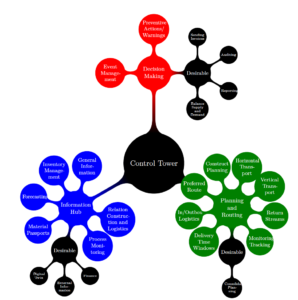Construction logistics account for 35% of urban freight traffic and emissions in cities. With the growth in construction projects and the plans to reduce greenhouse gas emissions, better coordination of construction logistics for city development is necessary. TUDelft student Tom Tesselaar wrote his thesis about designing a construction logistics control tower for city development.
Currently, construction logistics in city development is not well-coordinated leading to too much transport, delays, congestion, and construction errors. There are many reasons why coordination in construction supply chains is complicated. Some reasons result from the nature of the construction industry which is considered to be fragmented, complex, converging, typified as make-to-order, project-driven, and having to work with small urban construction sites. There is not a clear division of responsibilities between the many stakeholders in the construction supply chain. Complexity also originates from a lack of trust, no information sharing, and ‘old’ behavior.
Improving coordination of construction logistics in city development
Coordination can be achieved through the use of ICT systems. Some systems coordinate the supply and demand of an organization (ERP) or try to coordinate the planning of several organizations (APS). Other systems specifically plan logistical operations (TMS) or warehouse operations (WMS). None of these systems is designed to coordinate logistics, planning, and supply and demand of an entire supply chain, or cluster of local construction projects.
There are is a concept that might help coordinate multiple organizations and multiple supply chains; a control tower, or more specifically a construction logistics control tower. A construction logistics control tower can be defined as a central node that monitors, plans, and coordinates logistical processes for one or more construction projects by integrating relevant information systems and data sources. As the definition implies, a control tower is a central system that is in contact with all relevant stakeholders. It could be a physical place, fully cloud-based, or a combination of the two, depending on further developments and implementation.
Planning and routing, an information hub and decision making
During the research, the information available in different organizations in the construction supply chain was mapped. This information was considered as input for the construction logistics control tower. The output of the control tower is a combination of functionalities found through interviews and literature review. In total 15 functionalities have been described, in three categories: planning and routing, an information hub, and decision making. The planning and routing functionalities concerns what moves where, for whom, at what time and in what volumes. A control tower also functions as a hub where information is stored, shared, and analyzed. The third category encompasses decision making on the available information.
Benefits of a control tower
The control tower will take care of the communication between the organizations involved in projects in the designated area. The control tower will gather the overall material demand for a specific geographical area, and communicate this total demand with wholesalers/suppliers and logistics service providers. In doing so the control tower creates the potential for improving the material stream going in the area. Fewer vehicles are needed as consolidation can be achieved with higher load factors. Route and delivery information can be communicated directly to the logistics service providers, along with relevant information from the construction logistical plans or BLVC documents. The deliveries are planned to meet the requirements of the construction processes on time and at the right cost. These processes are monitored and analyzed using KPI’s to see whether the construction project is going according to the initial plans. These KPI’s are also used to make forecasts to adjust transport and construction schedules to optimize logistics and minimize nuisance and downtime.
Other benefits are: single point of contact, central information flow, choice in information sharing through modules, guaranteed access to information, coordinated construction logistics for an entire area, coordinated information about roadblocks, less traffic, higher load factors, and lower nuisance and greenhouse gas emissions.
A potential downside is that some stakeholders might have to change their business model, and that preferred wholesalers/suppliers of a contractor might not be chosen by the control tower. Transparency might lead to new roles in the supply chains.
Open data
A construction logistics control tower should be open for organizations involved in the construction projects in a certain area, according to Tom Tesselaar. Some information should even be public as it could aid in relations with residents of the area, or provide emergency services with crucial information about roadblocks and traffic. The facilitation of a control tower should be done by a neutral, impartial, capable, reliable, and most of all trustworthy organization. This organization could help during further developments, but also in the creation of a more common shared vision of a control tower.
Source: Thesis Tom Tesselaar

